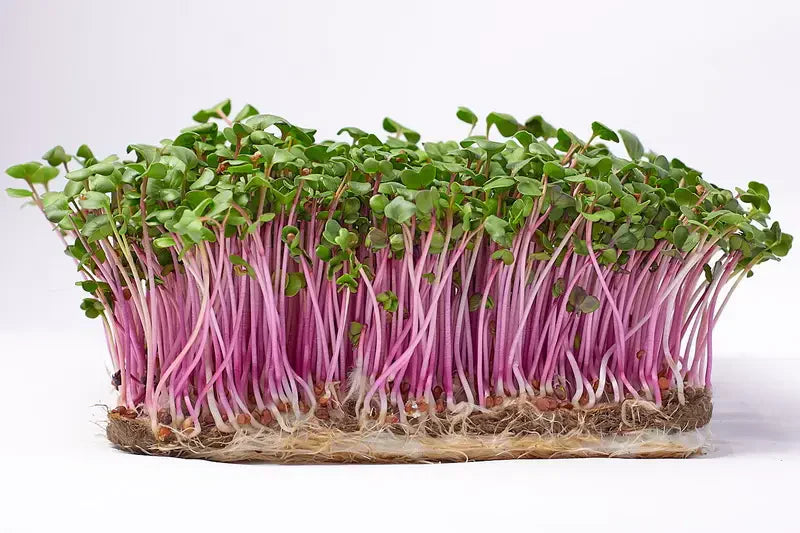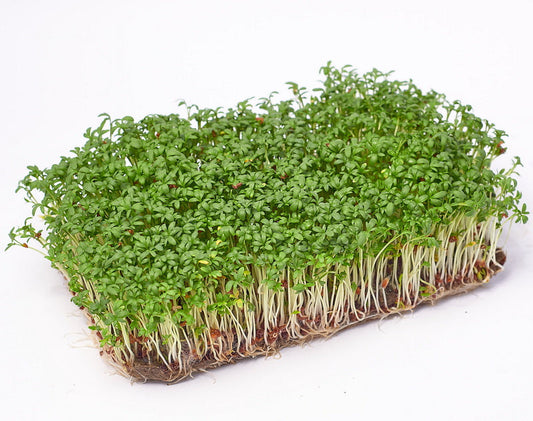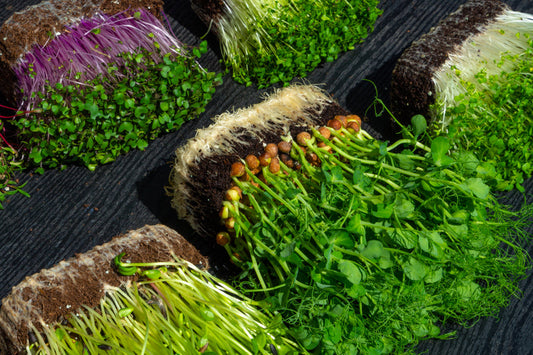
Exploring Radish Microgreens: A Colorful World of Flavor and Health
Share
Exploring Radish Microgreens: A Colorful World of Flavor and Health
Hey there, Ivan from Green Chief here! Today I'm excited to share my passion for radish microgreens with you. These tiny powerhouses aren't just adorable versions of their full-grown counterparts -- they're nutritional goldmines that can transform your meals with minimal effort!
The Radish Rainbow: Understanding Different Varieties
Let's dive into the fascinating world of radish microgreen varieties:
China Rose — My personal favorite for its vibrant pink stems and mild peppery flavor (3/5 on the spice scale). These beauties grow slightly slower than other varieties (ready in 8-10 days) but reward your patience with a gorgeous pop of color and gentle heat that won't overwhelm your palate. They have excellent shelf life, staying fresh for up to 7 days when refrigerated properly.

Red Coral — Don't be fooled by its delicate appearance! Red Coral packs a stronger spicy punch (4/5 on the spice scale) than China Rose and grows remarkably quickly (ready in 7-8 days). The stems have a lovely crimson hue, and the leaves offer that classic radish bite that wakes up your taste buds. Red Coral yields approximately 15% more harvest by weight compared to other varieties when grown under identical conditions.

Daikon — The mildest of the bunch (2/5 on the spice scale), Daikon microgreens are perfect for those who enjoy subtle flavors. They feature light green leaves with whitish stems and a refreshing crispness that works wonderfully in delicate dishes. Daikon sprouts are often the first to emerge (sometimes within 24 hours of planting) and typically ready for harvest in just 6-8 days, making them ideal for impatient gardeners.

Purple Sango — The showstopper! With its striking purple stems and green leaves, Purple Sango brings dramatic visual appeal alongside a medium spicy flavor (3.5/5 on the spice scale). I find these particularly excellent for garnishing special dishes when you want that "wow" factor. They're slightly more heat-sensitive during germination, preferring temperatures between 18-22°C for optimal growth, and typically ready to harvest in 8-9 days.

Variety Comparison Table
| Variety | Growth Time | Spice Level (1-5) | Yield | Best Uses | Shelf Life |
|---|---|---|---|---|---|
| China Rose | 8-10 days | 3/5 | Medium | Garnishes, salads | 6-7 days |
| Red Coral | 7-8 days | 4/5 | High | Sandwiches, spicy dishes | 5-6 days |
| Daikon | 6-8 days | 2/5 | Medium-high | Smoothies, delicate dishes | 4-5 days |
| Purple Sango | 8-9 days | 3.5/5 | Medium | Visual presentation, garnishes | 5-6 days |
Health Benefits: Tiny Greens, Massive Impact
What makes these little greens so special? According to Dr. Sarah Jenkins, PhD in Plant Biochemistry at Urban Farming Institute and author of "Microgreen Nutrition" (2023), "Radish microgreens contain significantly higher concentrations of key nutrients than their mature counterparts. Our analysis shows they're especially rich in vitamins C, E, K, and antioxidants that support immune function."
A 2022 study published in the Journal of Food Science found that radish microgreens contain:
- Vitamin C: 29mg per 100g (compared to 15mg in mature radishes)
- Vitamin E: 87mg per 100g (nearly 40 times the concentration in mature radishes)
- Significant amounts of glucosinolates, compounds known for their cancer-preventive properties
Some impressive benefits include:
- Concentrated nutrients — Higher levels of vitamins and minerals per gram than full-grown radishes, with Purple Sango and China Rose varieties showing particularly high antioxidant content
- Digestive support — Natural enzymes that aid digestion and gut health, particularly abundant in Daikon varieties
- Detoxification properties — Compounds that help your body eliminate toxins, with Red Coral showing the highest concentration of detoxifying glucosinolates
- Anti-inflammatory effects — Beneficial for overall health and reducing inflammation, supported by research from the European Journal of Nutrition (2021)
Growing Your Own Radish Microgreens: Expert Guidance
Want to grow these beauties at home? Here's my detailed step-by-step guide:
-
Gather supplies: You'll need:
- Quality radish seeds (15-20g will cover a standard 25×25 cm tray)
- A shallow tray with drainage holes
- Growing medium (coconut coir or flax seed mats)
- Spray bottle for watering
- Optional: pH meter (ideal pH range: 6.0-6.5)
- Prepare your tray: If using coconut coir, fill your container with about 2-3 cm of pre-moistened medium. For flax seed mats, simply place the pre-cut mat in your tray and thoroughly moisten it. For optimal results, ensure the growing medium is damp but not soggy.
- Sow seeds: Sprinkle seeds densely across the surface—aim for 60-80 seeds per 10 cm² (about 15-20g per standard 25×25 cm tray). For radish microgreens, seeds should be placed very close together but ideally not stacked on top of each other. This dense sowing is crucial for high yields and helps the seedlings grow straight upward as they compete for light.
- Cover lightly: If using coconut coir, add a thin layer of medium on top (about 3 mm). If using flax seed mats, you can skip this step as the seeds will anchor themselves to the mat surface. This helps maintain moisture and provides stability for the developing roots.
- Initial watering: Use your spray bottle to moisten everything thoroughly without disturbing the seeds. The medium should be completely moist but not waterlogged.
- Blackout period: Cover with another tray or a dark towel for 3-4 days to encourage strong germination. Maintain temperature between 18-24°C during this phase—cooler temperatures slow germination, while temperatures above 26°C can cause stress.
- Introduce light: Once sprouts reach about 2-3 cm tall, remove the cover and place in indirect sunlight or under grow lights (14-16 hours daily). Direct sunlight can scorch delicate seedlings.
- Ongoing care: Mist once daily, preferably in the morning. After day 5, transition to bottom watering by placing your tray in 1 cm of water for 5 minutes, then removing—this prevents fungal issues and strengthens stems.
- Harvest time: In just 6-10 days total (depending on variety), your microgreens will be ready! Cut just above the growing medium when they've developed their first true leaves, using sharp, clean scissors to prevent crushing the delicate stems.
Urban farming expert John Martinez, founder of Microgreens Barcelona with over 15 years of commercial growing experience, advises: "The key to successful radish microgreens is consistent moisture without overwatering. I monitor ambient humidity and adjust watering accordingly—40-50% humidity requires daily watering, while 60%+ humidity might need watering only every other day. And always ensure good air circulation to prevent mold issues, especially in winter months when windows stay closed."
Troubleshooting Common Issues
| Problem | Cause | Solution |
|---|---|---|
| Leggy, pale seedlings | Insufficient light | Move closer to light source or increase light duration |
| Mold or fungus | Excessive moisture, poor air circulation | Reduce watering, improve ventilation, try bottom watering |
| Slow growth | Temperature too low | Maintain 18-22°C for optimal growth |
| Seeds not germinating | Old seeds or improper storage | Use fresh seeds, store in cool, dry place |
| Yellowing leaves | Overwatering or nutrient deficiency | Adjust watering schedule, consider organic fertilizer at 1/4 strength |
Seasonal Growing Considerations
Winter (Below 18°C indoor temperature)
- Germination may take 1-2 days longer
- Reduce watering frequency as evaporation decreases
- Consider a heat mat to maintain soil temperature
- Watch for condensation that might encourage mold
Summer (Above 24°C indoor temperature)
- Increase ventilation to prevent heat stress
- Water more frequently, possibly twice daily
- Choose a cooler location away from windows
- Purple Sango may struggle in higher temperatures—consider focusing on heat-tolerant varieties like Red Coral
Culinary Uses: From Garden to Gourmet
What can you do with these peppery delights? Here's how to pair each variety with complementary flavors:
China Rose pairs beautifully with:
- Creamy cheeses (goat cheese, brie)
- Citrus (especially orange and grapefruit)
- Mild fish dishes
- Apple and pear
Red Coral complements:
- Robust meats (steak, duck)
- Strong cheeses (blue cheese, aged gouda)
- Earthy foods (mushrooms, beets)
- Dark chocolate (try it in desserts!)
Daikon enhances:
- Delicate fish and seafood
- Asian-inspired dishes
- Cucumber and light summer foods
- Fruity vinaigrettes
Purple Sango shines with:
- Anything requiring visual drama
- Neutral foods that showcase its color
- Citrus dressings
- Elegant canapés
Simple Signature Recipes
China Rose Citrus Salad
- 2 handfuls mixed greens
- 1 orange, segmented
- 1 handful China Rose microgreens
- 30g crumbled goat cheese
- 2 tbsp olive oil
- 1 tbsp fresh lemon juice
- Salt and pepper to taste
Combine ingredients just before serving for a refreshing starter.
Spicy Red Coral Avocado Toast
- 1 slice sourdough bread, toasted
- 1/2 ripe avocado, mashed
- Squeeze of lime juice
- Pinch of sea salt
- Generous handful of Red Coral microgreens
- Sprinkle of chili flakes
The spicy microgreens complement the creamy avocado perfectly.
Daikon Microgreen Soup Garnish
Float fresh Daikon microgreens on creamy soups just before serving—they add a crisp texture and mild flavor that works particularly well with carrot, potato, or cauliflower soups.
Purple Sango Caprese Skewers
Thread cherry tomatoes, mini mozzarella balls, and basil leaves on toothpicks, then "plant" them in a bed of Purple Sango microgreens for a stunning appetizer.
Storage and Preservation
To maximize shelf life:
- Harvest with clean, sharp scissors
- Dry completely before storage (use paper towels)
- Store in a container lined with paper towels
- Keep refrigerated at 2-4°C
- Change paper towels if moisture accumulates
- Don't wash until ready to use
Pro tip: For commercial growers, I've found that biodegradable clamshell containers with small ventilation holes extend shelf life by 1-2 days compared to sealed plastic bags.
Commercial Growing Considerations
For those considering small-scale commercial production:
- Space efficiency: A standard 60×40 cm tray yields approximately 250-300g of radish microgreens
- Profit potential: Current market rates in Europe range from €2-4 per 50g package
- Labor requirements: Expect 15-20 minutes of care per tray across the growing cycle
- Return on investment: Typically achieved within 2-3 months with consistent weekly production
According to European Microgreens Association data, radish varieties consistently rank in the top 5 most profitable microgreens due to their quick growth cycle and popularity among chefs.
Fun Facts & Research
Did you know that the vibrant colors in radish microgreens come from anthocyanins — the same compounds found in blueberries and other superfoods? A 2023 study in the International Journal of Molecular Sciences found that Purple Sango radish microgreens contain up to 30% more anthocyanins than China Rose varieties, making them particularly potent antioxidants.
Research from Wageningen University in the Netherlands has demonstrated that radish microgreens grown under specific LED light conditions (higher in blue spectrum) develop up to 20% more glucosinolates than those grown under standard fluorescent lighting.
Frequently Asked Questions
- Q: Can I reuse the growing medium?
- A: For home use, you can compost used coconut coir and reuse it at 50/50 with fresh medium. Flax seed mats are generally single-use but are biodegradable. For commercial production, I recommend always using fresh medium to minimize disease risk.
- Q: How many harvests can I get from one planting?
- A: Unlike some microgreens, radish varieties are generally single-harvest crops. They don't regrow well after cutting.
- Q: Are radish microgreens suitable for children?
- A: Absolutely! The milder Daikon variety is particularly kid-friendly, while spice-loving children might enjoy the challenge of Red Coral.
- Q: Can I grow radish microgreens hydroponically?
- A: Yes, they perform excellently in hydroponic systems, particularly using the float method or grow mats.
Wrapping Up
Whether you're drawn to the gentle heat of China Rose, the bold punch of Red Coral, the subtle elegance of Daikon, or the dramatic flair of Purple Sango — radish microgreens offer something for everyone. These tiny plants deliver massive nutritional benefits and culinary versatility while being incredibly easy to grow at home or as a small business venture.
Ready to start your microgreen journey? Pick your favorite variety (or try them all!) and watch as these little seeds transform into nutritional powerhouses right before your eyes. Your taste buds — and your body — will thank you!
Until next time, happy growing!
— Ivan, your Green Chief











